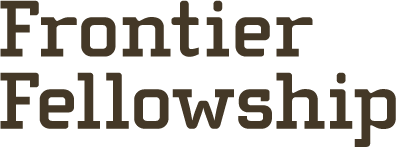Sarah Baugh

Sarah Baugh is a graphic designer based in Los Angeles. She has worked with the following: J.Crew, Hearst Digital Media, Wieden+Kennedy, Wilder Quarterly, Instrument, MakeLike, Pattern People, Sincerely Interested, Open Engagement, Good Ideas for Cities, and Know Your City. Following her Frontier Fellowship in 2012, Baugh would partner with Nicole Lavelle to create The Green River Newspaper (2013), The Green River Magazine (2014), and Interstate Works (2016).
“I feel very proud of what we accomplished here. We started with very little. Now all my shelves are full. I’m running out of space.”
Jo Anne Chandler, Green River Archivist
It’s a hot summer day and the parking lot at the John Wesley Powell River History Museum is dotted with cars. Tourists, outdoor enthusiasts, and road trippers trickle in, perhaps to escape the heat, and find themselves face-to-face with an animatronic river explorer, while being introduced to the geological features the Green River. In the basement, past the dinosaur skeletons, there are two less frequented rooms. These rooms are brimming with past stories of everyday people who have called Green River home. These stories, memories, documents, and artifacts span generations. Photographs and newspaper clippings are packed into three-ring binders. There are books, a military uniform, quilts, film footage of Crystal Geyser from the 1930s, models of missiles, bottle caps, a scale from the old general store, and boxes of rock core samples. Without the work of one women, these things would not be accessible to the public.
Jo Anne Chandler started the Green River Archives from scratch in 2004 after spending time volunteering at the museum. While the archive is less than a decade old, Jo Anne has been passionate about historical records since she was 16. A trip to Salt Lake City to stay with a friend’s grandmother set the stage for her future endeavors. She explains, ”I walked in Grandma Nelson’s front door and on her wall was a four foot square genealogy chart. Now all the little blanks were filled in. There were no blank spots on that chart. And I was drawn to it like a magnet”.
Jo Anne, who is self-taught, continues to build the collection, piece by piece, with the help of the community. Current projects include a giant handmade book outlining the history of Green River in ten year increments and the Veterans Project, five painted plywood boards that display the names local veterans whose service ranges from the Civil War to present conflicts.
When I ride my bike around town I am drawn to the river, and I follow silvery and shrubby trees all the way there. The trees guard the riverbank, spread out along the streets, and then disappear as the town gives way to desert. They are a distinguishing feature of Green River, much like the Book Cliffs and the river.
Recently, I read an interview with Gene Dunham from 1999, in which he tells oral historian Steve Allen that “the new encroachment is the Russian Olives. The river in fifty years will be completely different than it is today because of the Russian Olives. I’m more sure that they won’t beat the Tamarisks down."
“Russian Olives? I thought the Tamarisk was a restaurant?”
Future Frontier Fellow Justin Flood and I rode down to the river to investigate and identify these newcomers. Neither of these species are native to the United States and in a relatively short amount of time they have changed the landscape of the Colorado Plateau.
The fruit of the Russian Olive is edible and according to Justin, "the definition of mealy”.
Collage of materials from the Green River Archives by Baugh











